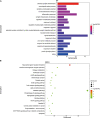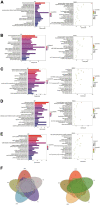Evaluation of pharmacological activities and active components in Tremella aurantialba by instrumental and virtual analyses
- PMID: 36570135
- PMCID: PMC9767953
- DOI: 10.3389/fnut.2022.1083581
Evaluation of pharmacological activities and active components in Tremella aurantialba by instrumental and virtual analyses
Abstract
As a kind of medicinal and edible homologous fungus, there is a lack of data on the medicinal value of Tremella aurantialba. In this study, ultra-performance liquid chromatography-quadrupole-time of flight-mass spectrometry (UPLC-Q-TOF/MS) was used to screen the chemical components in T. aurantialba. Then, network pharmacology was used to reveal the potential biological activities, active compounds, and therapeutic targets of T. aurantialba. Finally, the potential binding sites of the active compounds of T. aurantialba and key targets were studied by molecular docking. Results showed that 135 chemical components in T. aurantialba, especially linoleic acid, and linolenic acid have significant biological activities in neuroprotective, anticancer, immune, hypoglycemic, and cardiovascular aspects. The existence of these bioactive natural products in T. aurantialba is consistent with the traditional use of T. aurantialba. Moreover, the five diseases have comorbidity molecular mechanisms and therapeutic targets. The molecular docking showed that linolenic acid, adenosine, and vitamin D2 had higher binding energy with RXRA, MAPK1, and JUN, respectively. This study is the first to systematically identify chemical components in T. aurantialba and successfully predict its bioactivity, key active compounds, and drug targets, providing a reliable novel strategy for future research on the bioactivity development and utilization of T. aurantialba.
Keywords: Tremella aurantialba; active compounds; biological activity; component analysis; drug targets; virtual screening.
Copyright © 2022 Yan, Wang, Gan, Wang, Fu, Li, Chen, Lv and Zhang.
Conflict of interest statement
The authors declare that the research was conducted in the absence of any commercial or financial relationships that could be construed as a potential conflict of interest.
Figures






Similar articles
-
Isolation, structures, bioactivities, application and future prospective for polysaccharides from Tremella aurantialba: A review.Front Immunol. 2022 Dec 8;13:1091210. doi: 10.3389/fimmu.2022.1091210. eCollection 2022. Front Immunol. 2022. PMID: 36569950 Free PMC article. Review.
-
Whole Genome Sequencing and Annotation of Naematelia aurantialba (Basidiomycota, Edible-Medicinal Fungi).J Fungi (Basel). 2021 Dec 22;8(1):6. doi: 10.3390/jof8010006. J Fungi (Basel). 2021. PMID: 35049946 Free PMC article.
-
Physicochemical Properties and Microbial Quality of Tremella aurantialba Packed in Antimicrobial Composite Films.Molecules. 2017 Mar 22;22(3):500. doi: 10.3390/molecules22030500. Molecules. 2017. PMID: 28327535 Free PMC article.
-
A preliminary study of the chemical composition and bioactivity of Bombax ceiba L. flower and its potential mechanism in treating type 2 diabetes mellitus using ultra-performance liquid chromatography quadrupole-time-flight mass spectrometry and network pharmacology analysis.Front Nutr. 2022 Oct 13;9:1018733. doi: 10.3389/fnut.2022.1018733. eCollection 2022. Front Nutr. 2022. PMID: 36313078 Free PMC article.
-
High-efficiency production of Tremella aurantialba polysaccharide through basidiospore fermentation.Bioresour Technol. 2020 Dec;318:124268. doi: 10.1016/j.biortech.2020.124268. Epub 2020 Oct 17. Bioresour Technol. 2020. PMID: 33099097 Review.
Cited by
-
The foundation of the rhubarb industry economy: investigating metabolites disparities of rhubarb between varieties and growing environments on the Tibetan plate.Front Pharmacol. 2024 Sep 27;15:1461523. doi: 10.3389/fphar.2024.1461523. eCollection 2024. Front Pharmacol. 2024. PMID: 39399469 Free PMC article.
References
-
- Yang L, Li R, Cao Y, Li M, Luo X, Yang X, et al. Research on the scientific name and taxonomic status of Tremella aurantialba. Edible Med Mushrooms. (2020) 28:252–5.
-
- Subbulakshmi M, Dhanasekaran S, Abirami S, Kannan M, Palaniappan R, Venugopal D. Phylogenetic analysis and protective effects of thymol and its chromatographic fractions from a novel wild mushroom in combating oxidative stress. Food Sci Hum Wellness. (2021) 10:452–9. 10.1016/j.fshw.2021.04.007 - DOI
-
- Dan A, Hu Y, Chen R, Lin X, Tian Y, Wang S. Advances in research on chemical constituents and pharmacological effects of Paecilomyces hepiali. Food Sci Hum Wellness. (2021) 10:401–7. 10.1016/j.fshw.2021.04.002 - DOI
-
- Hou R, Liu X, Wu X, Zheng M, Fu J. Therapeutic effect of natural melanin from edible fungus Auricularia auricula on alcohol-induced liver damage in vitro and in vivo. Food Sci Hum Wellness. (2021) 10:514–22. 10.1016/j.fshw.2021.04.014 - DOI
LinkOut - more resources
Full Text Sources
Other Literature Sources
Research Materials
Miscellaneous

